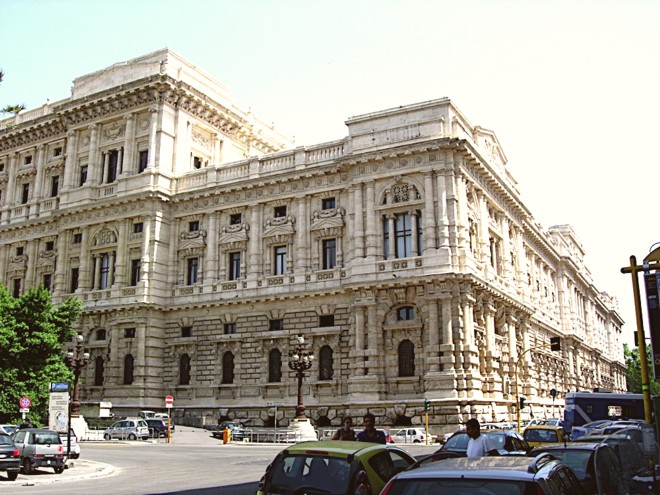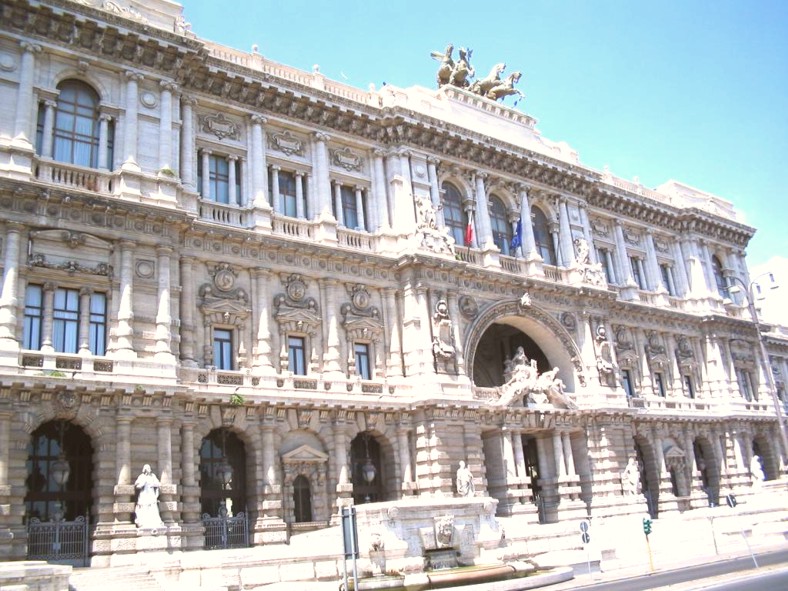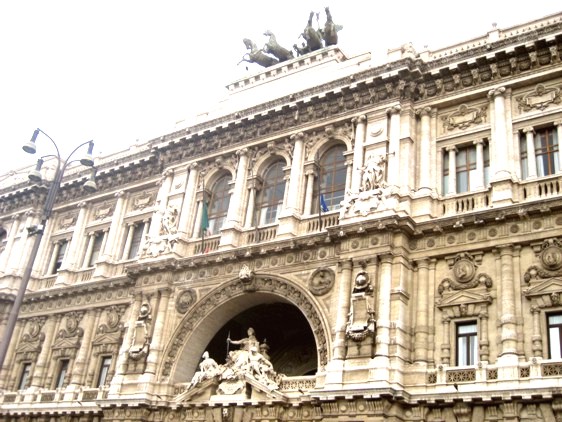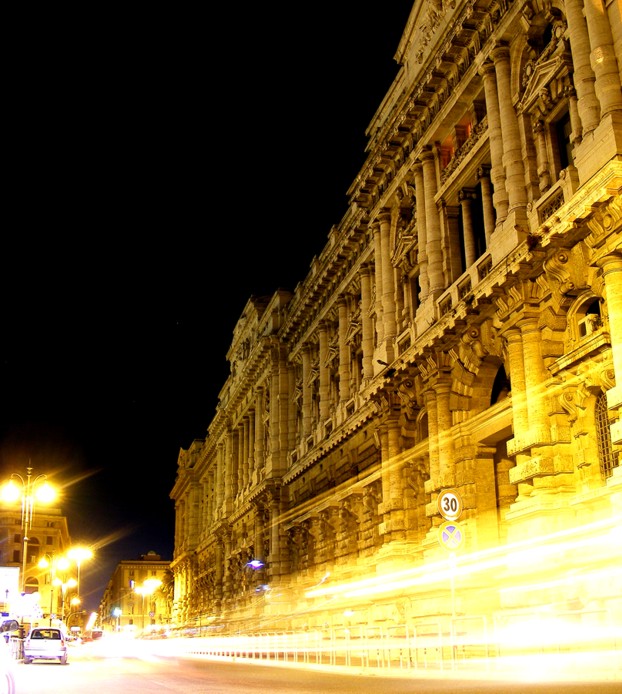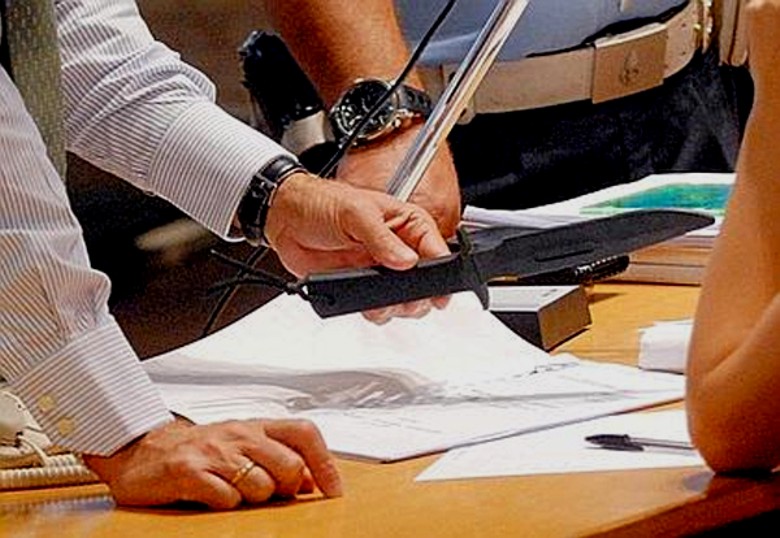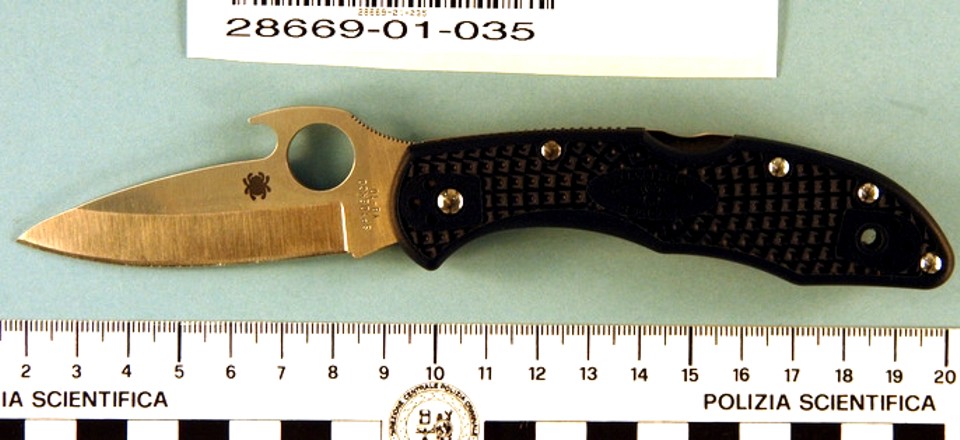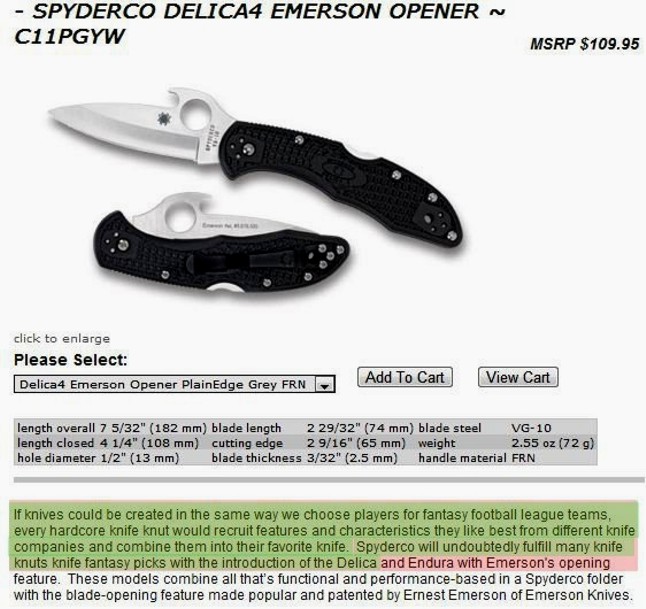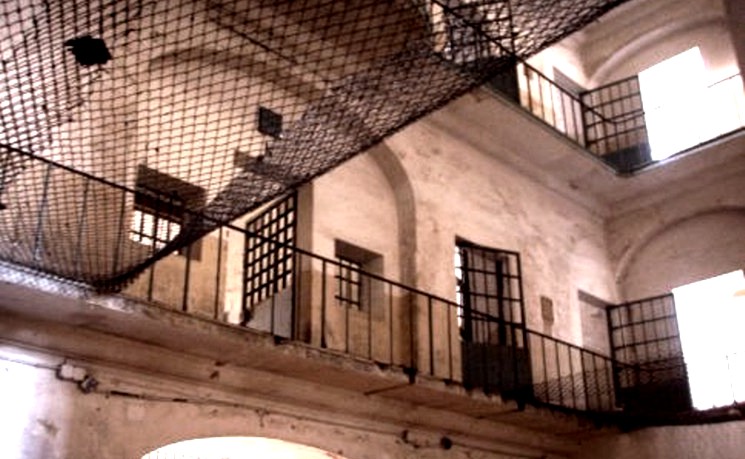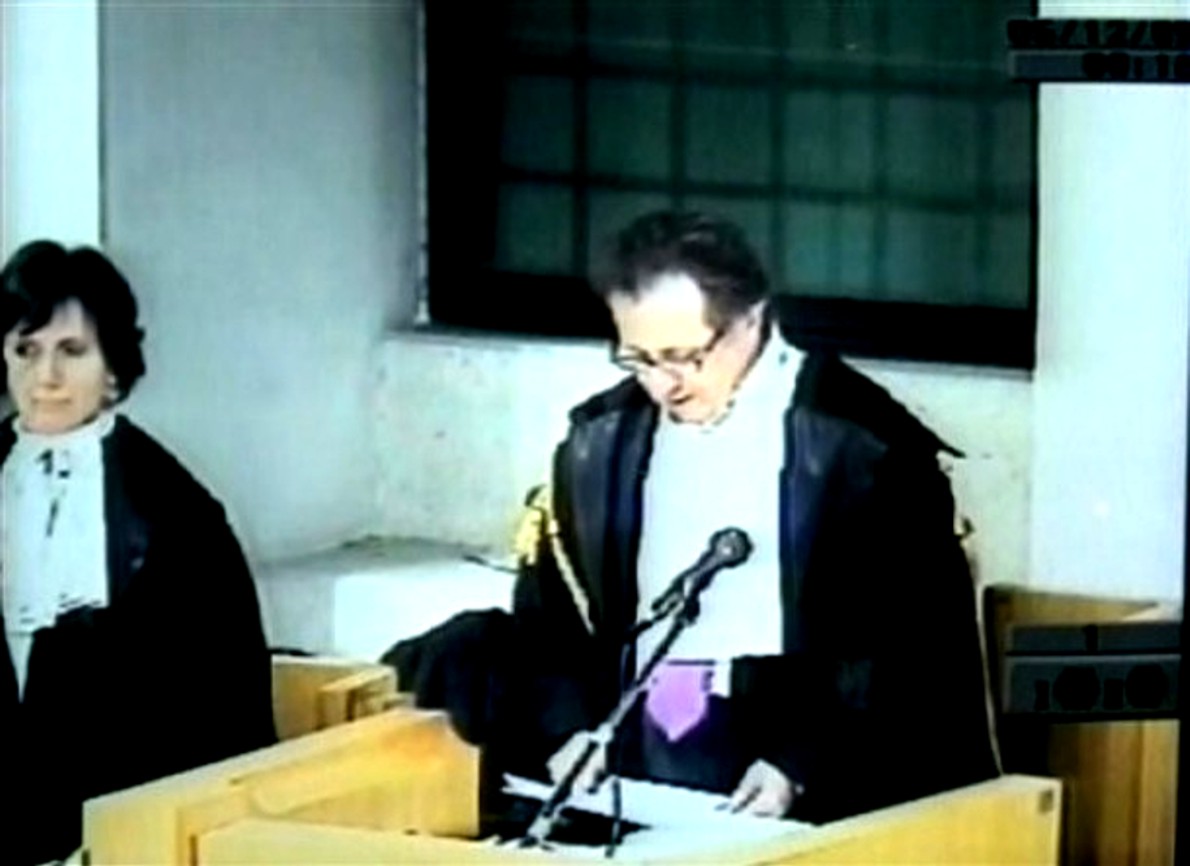
Category: Raff Sollecito
Thursday, January 20, 2011
The New 80,000 Pound Gorilla In The Room Introduced By The Italian Supreme Court
Posted by Our Main Posters

[St Peter’s and the Vatican in background; Palace of Justice, large white building by river in left foreground]
What is the biggest headache for the defenses?
That their areas of appeal, already circumscribed by Judge Hellman, could all explode in their faces? The low-credibility witnesses Alessi and Aviello? The limited DNA retesting? The re-examination of the witness in the park who had no cause to make anything up?
Or that Rudy Guede gets totally ticked off by Alessi’s claims that Rudy Guede said he did it with one or two others, and so Guede tells the court all that REALLY happened?
No, it looks to us that the defenses’ biggest headache by far is that the court of final appeal in Rome (the Supreme Court of Cassation, which is superior to the Perugia appeals court and will hear the second and final appeal) has ALREADY accepted that Rudy Guede’s sentencing report of January 2009 holds up.
And that all three of them attacked Meredith.
The written report from Cassation on that December 2010 decision on Guede’s final appeal (due soon), plus Judge Micheli’s Sentencing Report for Rudy Guede of January 2009, plus all that associated evidence, now gets automatically ported by law straight into Knox’s and Sollecito’s appeal.
Judge Micheli took a hard line toward Rudy Guede, and he sentenced him to 30 years. He also remanded Knox and Sollecito to trial, and his report explains the basis for that remand.
Judge Micheli’s remorseless and tightly argued report (see summaries below) very comprehensively backed up his decisions. (Later reductions in sentence were automatic and they flowed from the terms of Guede’s short-form trial, and some controversial mitigating circumstances advanced by Massei for Knox and Sollecito.)
The prosecution’s appeal against the Knox and Sollecito sentences argues that the acceptance of mitigating circumstances by the Massei court should be thrown out, and that Knox and Sollecito should be subjected to a longer sentence. Remember that even in the case of Alessi’s wife, who was not even present when he beat the kidnapped baby to death, she received a sentence of 30 years.
So here is how it is stacking up:.
- For the prosecution, four courts including the Supreme Court of Cassation have ruled that three people participated in the crime against Meredith, plus all of the evidence from both the Guede and Knox Sollecito trials now comes in, plus the prosecution is appealing for tougher sentences, which seems well justified based on precedents.
- For the defenses, just those few areas the defenses want to challenge which have been allowed by Judge Hellman NONE of which are sure things.
Really not very much going for the defenses here. No wonder they already seem to be phoning it in.
Our meticulous summaries of the Micheli Report by main posters Brian S and Nicki were based on our own translation. A huge amount of work. They were posted nearly two years ago. Periodically we link to them in other posts or we point to them in an email.
Those who do read those posts fresh are often stunned at their sharpness, and for many or most it becomes case closed and the verdict of guilty is seen as a fair one.
We think those posts on Micheli are so key to a correct grasp of Knox’s and Sollecito’s appeal prospects that they should now be reposted in full.

[St Peter’s and the Vatican in foreground; Palace of Justice, large white building in left background]
Understanding Micheli #1: Why He Rejected All Rudy Guede’s Explanations As Fiction
By Brian S
Judge Micheli has had two very important roles. He presided over Rudy Guede’s trial and sentencing, and he presided over the final hearing that committed Raffaele Sollecito and Amanda Knox to trial.
A week ago, just within the three-month deadline, Judge Micheli made public the 106-page report that explains the thinking behind both actions. This is a public document, and in the enviable Italian legitimizing process, the public is encouraged to get and read the report and to understand the full rationales. Excellent analyses have already appeared in Italian in Italy, but no English-speaking sources on the facts of the case have either put the report into English or published more than the most superficial analysis.
These posts will examine several very key areas of the report so that we too may choose whether to buy into the rationales. The translations into English here were by native-Italian speakers and fellow posters Nicki and Catnip. The next post will explain why Micheli ruled out the Lone Wolf Theory, and why he concluded that Knox and Sollecito appeared to be implicated in Meredith’s murder and should therefore be sent to trial.
Judge Micheli maintained that from the moment Meredith’s body was discovered until his arrest in Germany on November 19th, Rudy Guede was in a position to compile a version of his involvement in events at the cottage which would minimise his reponsibilities and point the finger of guilt elsewhere.
He was able to follow the course of the investigation in newspapers and on the internet. He would know of the arrests of Amanda, Raffaele and Patrick. He would know that the investigators had found biological evidence which would sooner or later connect him to the murder, and he would know of other discoveries and evidence which had been publicised in the media.
His story as told in Germany was compiled with all the knowledge about the crime and investigation he would have sought out. On his return to Italy in December he was interviewed by the investigating authorities and gave version 2. He was interviewed again in March which resulted in version 3, and later still made a spontaneous statement to change one or two facts including the admission that the trainer footprint in Meredith’s room could be his. Judge Micheli said:
- Analyzing the narratives of the accused…he is not credible, as I will explain, because his version is (1) unreliable, and (2) continuously varying, whether on basic points or in minor details and outline.
Micheli then examined the details of Rudy’s claimed meeting with Meredith which resulted in his invitation to the cottage on the evening of November 1st.
He noted there were substantial differences between his versions of December and March, particularly with regard to the location of his meeting with Meredith on the night of Halloween and his movements in the early evening of November 1st.
He considered it likely that Rudy had made these changes as he became aware of evidence which contradicted his December version. Notably, in December Rudy claimed to have had his meeting with Meredith which resulted in her invite at a Halloween party given by Spanish students.
By March it was well known that Meredith had spent her entire Halloween in the company of friends, first in the Merlin pub before they later moved on to Domus disco. In March Rudy changed the location of his meeting with her from the Spanish party to Domus, which by chance Rudy had also attended following the party. However, neither Meredith’s friends who were continuously in her company nor those who accompanied Rudy to the Domus witnessed any meeting between the two. Judge Micheli commented:
- On 26 March 2008, instead, Rudy explained to the Prosecution, drawing a picture, that the group invited to the Spaniards’ house actually moved wholus-bolus to the “Domus” club, but it was right in that nightclub that he met Kercher, and not before; offering up a tour-guide description from the chair, saying, “there’s a bar for the drinks and then there’s a room, there’s an arch and a room. I walking [sic] around there, and that’s where I met Meredith”. On the facts of the meeting and the subject of the conversation, he elaborated: “I started talking to Meredith “¦talking anyway I gave her a kiss.. after which I told her how much I liked her and asked her if the next day, in all the confusion anyway, if we were going to meet the next day and she said yes (”¦), we met in the evening around half eight, like that.
While not intending to explore the question, basically irrelevant, of whether the pair had agreed to a more or less specific time (his confirmation of the suggestion of 8.30 pm in both verbal statements however allows the inference that according to Guede they had an appointment), the patent contradiction between the two versions jumps out. One context, of a room between two bathrooms, in an apartment, is completely different to that of a drinks-bar and an arch, in a pub; one might concede, perhaps, the possibility of forgetting which place it was where they last bumped into a friend, but hardly the first time there was a kiss with a girl towards whom one was attracted.
With regard to his movements in the early evening of November 1st, Rudy’s friend Alex failed to corroborate Rudy’s December claim to have visited his flat. He said he didn’t see Rudy either before or after his meeting with Meredith at her cottage.
In March, Rudy changed his story and claimed to have risen at 6pm(following the all-nighter at Domus) before wandering around town for an hour or so. He then said he went to Meredith’s cottage but received no answer so he carried on to Piazza Grimana in the hope he might see people he knew. He thought he arrived in the Piazza at around 7:30pm. He claimed that some time later he left Piazza Grimana and called at the Kebab shop before returning to Meredith’s cottage and arriving some time between 8:30 and 9:00pm.
He said he then waited until her arrival some time just after 9:00pm. It was noted that in both his December and March versions Rudy said he had arranged to meet Meredith at 8:30pm. Micheli noted that this didn’t sit well with another arrangement Rudy had made to meet Carlos (from the Spanish party) between 9:00 and 10:00pm.
Micheli said that neither version of Rudy’s movements could be treated as true because he changed his story to fit facts as they became known and there was absolutely no corroborating witness evidence.
Rudy claimed two situations evolved following his entry with Meredith into the apparently empty cottage:
Whilst he was having a drink of fruit juice from the fridge, he claims Meredith found that 300 euros (her rent money) was missing from her bedside cabinet. Meredith was naturally upset by this discovery and straight away blamed “druggy Amanda”. Rudy said they both checked Amanda’s room to see if the money was there. However, it couldn’t be found and Rudy sought to console her.
He says that this consolation developed into an amorous encounter which proceeded to the stage where “Meredith asked him” if he had a condom. He told he didn’t and since she didn’t either they stopped their lovemaking.
Judge Micheli had a real problem with this story as told by Guede. He found it unlikely that Meredith would be interested in lovemaking so soon following the discovery that her money was missing. He found it unlikely that it was Meredith who was leading the way in this amorous encounter as Rudy was suggesting with his claim that it was “Meredith who asked him” if he had a condom.
Surely, Micheli reasoned, if Rudy was hoping to indulge in a sexual encounter with Meredith following the previous night’s flirting, he would, as any young man of his age, ensure that he arrived with a condom in anticipation of the hoped for liason. But even if he didn’t, and it was true that events had reached the stage where Meredith asked him, then surely given his negative response, Meredith would have again gone into Amanda’s room where, as she had told her friends, condoms were kept by her flat mate. Judge Micheli simply didn’t believe that if they had got to the stage of lovemaking described by Rudy, and following his negative response to her question, they just “STOPPED”. Meredith would have known she had a probable solution just metres away.
Rudy claimed he then told Meredith he had an upset stomach because of the kebab he had eaten earlier. She directed him to the bathroom through the kitchen.
Rudy put on his i-pod and headphones as he claimed was his habit when using the toilet. In his December version Rudy said the music was so loud he heard the doorbell ring but he made no reference to hearing any conversation. A perfect excuse, Judge Micheli says, for not hearing the disturbance or detail of Meredith’s murder. However, in his March version he claims he heard Amanda’s voice in conversation with Meredith. When Rudy did eventually emerge from the bathroom he says he saw a strange man with a knife and then a prone Meredith. Micheli commented:
- ...it is necessary to take as given that, in this case, Kercher did not find anything better to do than to suddenly cross from one moment of tenderness and passion with him to a violent argument with someone else who arrived at that place exactly at the moment in which Rudy was relieving himself in the bathroom. In any case, and above all, that which could have been a surprise to the killers, that is to say his presence in the house, was, on the other hand, certainly not put into dispute:
Meredith, unlike the attackers, knew full well that in the toilet there was a person who she herself allowed in, so for this reason, in the face of someone who had started raising their voice, then holding her by the arms and ending with brandishing a knife and throwing her to the floor, why would she not have reprimanded/reproached/admonished him immediately saying that there was someone in the house who could help her?
“¦Meredith didn’t shout out loudly for Rudy to come and help
“¦There was a progression of violence
“¦The victim sought to fight back
If it is reasonable to think that a lady living 70 metres away could hear only the last and most desperate cry of the girl ““ it’s difficult to admit that Guede’s earphones, at 4-5 metres, would stop him hearing other cries, or the preceding sounds.
Micheli was also mystified as to why Amanda (named in Rudy’s March version) would ring the doorbell. Why wouldn’t she let herself in using her own key? He supposed it was possible Meredith had left her own key in the door which prevented Amanda from using hers, but the girls all knew the lock was broken and they were careful not to leave their own key in the door. Perhaps, Meredith wanted some extra security/privacy against someone returning and had left her key in the lock on purpose. Maybe Amanda was carrying something heavy and her hands weren’t free. Or, maybe, Rudy was just trapped by his December story of the doorbell when he didn’t name anybody and an anonymous ring on the doorbell was plausible.
The judge then took issue with Rudy’s description of events following the stabbing of Meredith. Rudy claimed that when he emerged from the bathroom he discovered a man with a knife standing over Meredith. In the resultant scuffle he suffered cut wounds to his hand. armed himself with chair to protect himself. before the attacker fled when he fell over because his trousers came down around his ankles. Micheli said that those who saw Rudy later that night didn’t notice any wounds to Rudy’s hands although some cuts were photographed by the police when he was later arrested in Germany.
Micheli found Rudy’s claim that the attacker ran from from the house shouting “black man found, black man guilty” unbelievable in the situation. In the panic of the moment it may be conceivable that the attacker could shout “Black man…, run” following the surprise discovery of his presence in the house, but in the situation Rudy describes, blame or expressions of who the culprit thought “the police would find guilty” made no sense. It would be the last thing on an unknown attackers mind as he sought to make good his escape.
Micheli considers the “black man found, black man guilty” statement an invention made up by Rudy to imply a possible discrimination by the authorities and complicate the investigation. Micheli also saw this as an excuse by Rudy to explain away his failure to phone for help (the implication being that a white man could have made the call). It was known by her friends and acquaintances that Meredith was never without her own phone switched on. She kept it so, because her mother was ill and she always wanted to be available for contact should her mother require help when she was on her own
Judge Micheli regarded Rudy’s claimed efforts to help Meredith impossible to believe, given the evidence of Nara Capezzali. Rudy claimed to have made trips back and forth to the bathroom to obtain towels in an attempt to staunch the flow of bood from Meredith’s neck. He claimed to have leaned over her as she attempted to speak and written the letters “AF” on the wall because he couldn’t understand her attempted words. His described activities all took time and Rudy’s flight from the house would have come minutes after the time he alleged the knife-man ran from the cottage.
Nara Capezzali maintained that after she heard Meredith’s scream it was only some seconds (well under a minute) before she heard multiple footsteps running away. Although she looked out of her window and continued to listen for some time because she was so disturbed by the scream, she neither heard nor saw any other person run from the house. That Rudy had run wasn’t in doubt because of his collision on the steps above with the boyfriend of Alessandra Formica. Micheli therefore considered it proven that “all” of Meredith’s attackers, including Rudy, fled at the same time.
Earlier in his report Micheli considered character evidence on Rudy given by witnesses for both prosecution and defense. Although he had been seen with a knife on two occasions, and was considered a bit of a liar who sometimes got drunk, the judge didn’t consider that Rudy had previously shown a propensity for violence, nor behaviour towards girls which differed markedly from that displayed by many other young men of his age.
However, because of the wealth of forensic evidence [on which more later] and his admitted presence in the cottage, combined with his total disbelief in Rudy’s statements, Micheli found Rudy guilty of participation in the murder of Meredth Kercher.
He sentenced him to 30 years in prison and ordered him to pay compensation of E2,000,000 each to Meredith’s parents John and Arline Kercher, E1,500,000 each to Meredith’s brothers John and Lyle Kercher plus E30,000 costs in legal fees/costs + VAT. Also E1,500,000 plus E18,000 in legal fees/costs + VAT to Meredith’s sister, Stephanie Kercher.
Understanding Micheli #2: Why Judge Micheli Rejected The Lone-Wolf Theory
By Brian S
And so decided that Raffaele Sollecito and Amanda Knox should face trial.
First, just to recap: Judge Micheli presided over both Rudy Guede’s trial and sentencing to 30 years and the final hearing that committed the two present defendants to trial.
Ten days ago, Judge Micheli made public the 106-page report that explains the thinking behind both actions. This is a public document, and in the enviable Italian legitimizing process, the public is encouraged to get and read the report and to understand the full rationales. Excellent analyses have already appeared in Italian in Italy, but no English-speaking sources on the facts of the case have either put the report into English or published more than the most superficial analysis.
These posts are examining several very key areas of the report so that we too may choose whether to buy into the rationales. The translations into English used here were by native-Italian speakers and fellow posters Nicki and Catnip.
Right at the outset of his Sentence Report on the conviction of Rudy Guede, Judge Micheli stated that it was neither the place nor his intention to make the case against either Raffaele Sollecito or Amanda Knox. He said he must necessarily involve them to the extent that they were present at the discovery of Meredith’s body. He said he must also examine evidence against them where he saw it as indicating that Rudy Guede was not a lone wolf killer and implicated them as his possible accomplices in Meredith’s murder.
Judge Micheli described the sequence of events laid out by the prosecution which lead to the discovery of Meredith’s body:
Early on the morning of November 2nd, Signora Lana Biscarini received a bomb threat call made to her home at 5A Via Sperandio. (This later transpired to be a hoax.)
Some time later Signora Biscarini found a mobile phone in her garden. She “had heard” that bombs could be concealed in mobile phones and so she took it to the police station arriving at 10:58am as recorded by ISP. Bartolozzi
The postal police examined the phone and following removal of the SIM card, discovered at 11:38am that it belonged to a Filomena Romanelli who lived at the cottage at 7 Via della Pergola. Following a call by Signora Biscarini to check with her daughter who was still at home, it is in the record at 11:50am that neither say they know the Filomena in question. At around noon Signora Biscarini’s daughter rings her mother at the police station to say she has found a second phone.
The second phone (Meredith’s) is collected from Via Sperandio and taken to the police station. Its receipt there is logged by ISP. Bartolozzi at 12:46pm. During its examination Meredith’s phone is also logged as connecting to the cell of Strada Borghetto di Prepo, which covers the police station, at 13:00pm. At 13:50pm both phones, which have never left the police station following their finding, are officially seized. This seizure is entered in the log at 14:00pm.
Separately, as part of the bomb hoax investigation, agents of the postal police are dispatched to make enquiries at Filomena’s address in Via della Pergola.
They are recorded in the log and filmed on the car park camera as arriving at 12:35pm. They were not in possession of Filomena’s phone, which remained at the police station, nor of Meredith’s which at this time was being taken from Via Sperandio to the police station for examination as part of the bomb hoax enquiry.
Judge Micheli said that some confusion was created by the evidence of Luca Altieri (Filomena’s boyfriend) who said he saw two mobile phones on the table at the cottage. But, Micheli said, these two phones either belonged to the others who arrived, the postal police themselves or Amanda and Raffaele. They were NOT the phones of Filomena or Meredith.
On their arrival at the cottage, the agents of the postal police found Raffaele Sollecito and Amanda Knox standing outside the front door.
The two seemed surprised to see them (the postal police had come to talk to Filomena about a bomb hoax which potentially involved her phone, plus they had recently been informed of the discovery of second phone in the same garden), but then they explained they had discovered suspicious circumstances inside the cottage.
Raffaele said he had already phoned the police and they were awaiting their arrival in connection with that. Elsewhere in his report Micheli points out that Raffaele did, in fact, make a call to his sister at 12:50pm, followed by two calls to “112” reporting a possible burglary at 12:51 and 12:54pm, 15 minutes after the arrival of the postal agents.
Judge Micheli said the postal police were shown into the cottage by Raffaele and Amanda. They pointed out the traces of blood around the apartment, the state of the toilet and the disturbance to Filomena’s room. They said they didn’t think anything had been taken. They pointed out that Meredith’s door appeared to be locked, Raffaele said he had tried to open it, but Amanda said Meredith used to lock the door even when she was going to the bathroom to shower.
Shortly afterwards Luca Altieri and Marco Zaroli arrived. Luca said he had just been contacted by his girlfriend Filomena, who in turn had just been contacted by Amanda Knox about the possible break in. A few minutes later, Filomena herself arrived with Paola Grande. Micheli noted that Filomena had immediately contradicted what Amanda had told the postal police and she said that Meredith never locked her door. She also told the postal police that the phone found with a SIM card in her name was in fact Meredith’s 2nd phone, that she had given Meredith the SIM as a present. The postal police said that they didn’t have the authority to damage property and so the decision was made that Luca would break down the door.
This he did. The scene when the door flew open was instantly obvious, blood everywhere and a body on the floor, hidden under a duvet except for a foot and the top of Meredith’s head. At that point ISP Battistelli instantly took charge. He closed the door and forbade anyone to enter the room before contacting HQ.
Following his description of the events which lead to the discovery of Meredith’s body, Micheli then dedicates quite a few pages of his report to detailing the exact locations, positions, descriptions and measurements of all the items, blood stains, pools and spots etc.etc. found in her room when the investigators arrived. He also goes into precise details on the injuries, marks, cuts and bruises etc. which were found by Lalli when he examined Meredith’s body in situ at the cottage before she was moved. Despite their extent, it is obvious these details are only a summary of the initial police report and also a report made by Lalli on the 2nd November.
It is these details which allowed the prosecution to lay out their scenario for the events which they say must have happened in the room. It is also these details which convince Micheli that it was impossible for this crime to be carried out by a single person. In his report, he dismisses completely the scenarios presented by the defences of Amanda and Raffaele for a “lone wolf killing”. Micheli says that he is convinced that Meredith was sexually assaulted and then murdered by multiple attackers.
Judge Micheli also explains in his report how the law will decide on sexual assault or rape where the medical report (as was Lalli’s) is somewhat inconclusive. Else there would be no point in a woman reporting rape unless she had serious internal injuries. His conclusion: Meredith was raped by Rudy Guede manually.
So why does Judge Micheli believe that Amanda Knox and Raffaele Sollicto were possible accomplices of Rudy Guede and should be tried for the murder of Meredith Kercher?
In his report, he doesn’t look at the evidence which involves just them, nor does he analyze their various stories in his report. He doesn’t look at events involving them which occurred between the 2nd and 5th November. He does note a few items here and there, but these aren’t given as the major reasons for his decision to indict them.
He notes Raffaele’s apparent lies about the time he made the 112 phone calls. He dismisses Raffaele’s defense claim that the disposal of Meredith’s phones didn’t allow time for Raffaele to get to the cottage after watching his film, kill Meredith, and then dispose of the phones in Via Sperandio before the aborted call to Meredith’s bank. He noted that the cell which picked up the brief 10:13 call to Meredith’s bank also picked up most of Meredith’s calls home.
He asked whether it was possible for anybody to believe that each time Meredith wanted to phone home, she walked down to Via Sperandio to make the call. He notes that the police found Amanda and Raffaele’s behaviour suspicious almost straight away. He notes that Filomena said that the relationship between Amanda and Meredith had deteriorated by October. He says he doesn’t believe at all that cannabis caused any loss of Amanda’s and Raffaele’s memories.
Judge Micheli says he bases his decision on the following points of evidence:
[Note: The following paragraph numbers form no part of Micheli’s report. They are used in the context of this summary to identify the points of evidence contained in his report which will be examined and summarised in greater detail in follow-up posts]
1) Judge Micheli, after hearing both prosecution and defense arguments about Meredith’s and Amanda’s DNA on the knife and Raffaele’s DNA on Meredith’s bra clasp, accepted the prosecution argument that that both were valid evidence. He did note, however, that he fully expected that the same argument would be heard again at the full trial. In his report, Micheli dedicates several pages to explaining the opposing arguments and how he made his decision to allow the evidence. It is a detailed technical argument, and it is not proposed to examine it any closer in this post.
2) Judge Micheli explains that blood evidence proves that Meredith was wearing her bra when she was killed. Nor is it just the blood on her bra which demonstrates this. It’s also where the blood isn’t on her body. He says that Meredith was wearing her bra normally when she laid in the position in which she died, and she was still wearing it for quite some time after she was dead. Her bra strap marks and the position of her shoulder are imprinted in the pool of blood in that position. Meredith’s shoulder also shows the signs that she lay in that position for quite some time.
He asks the question: Who came back, cut off Meredith’s bra and moved her body some time later? It wasn’t Rudy Guede. He went home, cleaned himself up and went out on the town with his friends. Judge Micheli reasons in his report that it could only have been done by someone who knew about Meredith’s death and had an interest in arranging the scene in Meredith’s room. Seemingly who else but Amanda Knox?
She was apparently the only person in Perugia that night who could gain entry to the cottage. And the clasp which was cut with a knife when Meredith’s bra was removed was found on November 2nd when Meredith’s body was moved by the investigators. It was right under the pillow which was placed under Meredith when she was moved by someone from the position in which she died. On that clasp and its inch of fabric is the DNA of Raffaele Sollecito and Amanda Knox. Micheli reasons in his report that Raffaele and Amanda seemed to have returned to the cottage some time after Meredith was dead, cut off her bra, moved her body, and staged the scene in Meredith’s room.
3) Judge Micheli explains his reasoning on the method of Rudy’s entry into the cottage. He says that Rudy’s entry through the window is a very unlikely scenario and the evidence also indicates otherwise. He says the height and position of the window would expose any climber to the full glare of traffic headlights from cars on Via della Pergola. He asks, why wouldn’t a thief choose to break in through a ground floor window of the empty house? He says the broken glass and marks on the shutter both demonstrate the window was broken from the inside, some of the glass even falling on top of Filomena’s clothes which had been thrown around the room to simulate a robbery.
But his major reasoning for believing Rudy’s entry was through the front door are the bloody bare footprints which show up with luminol and fit Knox’s and Sollecito’s feet. These suggest that they entered Filomena’s room and created the scene in there after Meredith was killed. Allessandra Formica witnessed Rudy run away shortly after Meredith was stabbed. Someone went back later, left those footprints and staged the scene.
This, when considered in combination with the knowledge that person demonstrated of Rudy’s biological involvement with Meredith when they also staged the sex assault scene in Meredith’s own room indicates that that person was present when Meredith was assaulted and killed. He said it also demonstrated an attempt by someone who had an interest in altering the evidence in the house to leave the blame at Rudy’s door. Micheli reasoned, the only person who could have witnessed Rudy’s earlier sex assault on Meredith, could gain entry via the door and had an interest in altering the crime scene in the house appeared to be Amanda Knox. In his report, Micheli states that this logic leads him to believe that Amanda Knox was the one who let Rudy Guede into the cottage through the front door.
4) Judge Micheli examines the evidence of Antonio Curatolo. He says that although Curatolo mixes up his dates in his statement, he does have a fix on the night he saw Amanda and Raffaele in Piazza Grimana sometime around 11:00 to 11:30pm. Curatolo is certain it was the night before the Piazza filled up with policemen asking if anyone had seen Meredith. In his evidence, he says they came into the square from the direction of Via Pinturicchio and kept looking towards the cottage at Via della Pergola from a position in the square where they could see the entrance gate.
Judge Micheli reasons in his report that their arrival from Via Pinturicchio ties in with the evidence from Nara Capazzali that she heard someone run up the stairs in the direction of that street. He also reasons that they were likely watching the cottage to see if Meredith’s scream had resulted in the arrival of the police or other activity.
5) Judge Micheli examines the evidence of Hekuran Kokomani and finds him far from discredited. His says the testimony is garbled, his dates and times makes no sense but…. that Hekuran Kokomani was in the vicinity of the cottage on both 31st Oct. and 1st Nov isn’t in doubt. Furthermore, Micheli says that when he gave his statement, the details which he gave of the breakdown of the car, the tow truck and the people involved weren’t known by anyone else. He must have witnessed the breakdown in Via della Pergola. The same breakdown was also seen by Allessandra Formica shortly after Rudy Guede collided with her boyfriend.
This places Hekuran Kokomani outside the cottage right around the time of Meredith’s murder and he in turn places Raffaele Sollecito, Amanda Knox and Rudy Guede together outside the cottage at the same time. His evidence also places all three outside the cottage at some time the previous night.
Judge Michelii found that all this evidence implicated Amanda Knox and Raffaele Sollecito as accomplices of Rudy Guede in the murder of Meredith Kercher.
Understanding Micheli #3: How Damning Is The DNA Evidence Coming Up?
By Nicki
Probable answer? Pretty damning.
Judge Micheli has had two very important roles. He presided over Rudy Guede’s trial and sentencing, and he presided over the final hearing that committed Raffaele Sollecito and Amanda Knox to trial.
Late January, Judge Micheli made public the 106-page report that explains the thinking behind both actions. These posts are examining several very key areas of the report so that we too may choose whether to buy into the rationales.
The trial to establish the truth about the murder of Meredith continues next Friday. As we’ve reported, various human witnesses have already been heard from: the Postal Police who discovered Meredith’s body, Meredith’s two Italian roommates, and her seven British friends.
Coming up soon is a more silent witness, one very important to both the prosecution and the two defenses: the DNA evidence.
Specifically the DNA belonging to Meredith, Knox, Sollecito, and Guede which was found at the scene of the crime, and on the suspected murder weapon found, apparently hidden, in Raffaele Sollecito’s house.
Traces of Meredith’s DNA have been found on a knife compatible with the wounds that caused her death. Amanda Knox “˜s genetic material was identified on the knife handle. DNA belonging to Sollecito has been found on the clasp of the victim’s bra. And more DNA showing Rudy Guede’s genetic profile was found on the victim’s body and elsewhere in the house.
In summary, the biological sources and locations where DNA belonging to the three defendants was found are these:
- Guede’s DNA (from epithelial cells) was found inside Meredith, on toilet paper, on the right side of Meredith’s bra, mixed with Meredith’s DNA on the her purse zip, and on the left cuff of Meredith’s light blue sweater
- Sollecito’s DNA (from epithelial cells) was found on Meredith’s bra clasp, mixed with Meredith’s DNA, and on one cigarette butt found in the kitchen
- Knox’s DNA (from epithelial cells) was found on the knife sheath, and close to the blade junction. It was not possible to ascertain both the haematic and epithelial source of Meredith’s DNA on the knife blade, due to the scarcity of the sample. But Judge Micheli noted that reasonable doubt persist that blood could have been present also.
- Other significant biological traces belonging to Meredith - for example, DNA originating from the blood-trace footprints revealed by luminol found in Filomena’s bedroom, as already reported at trial.
Claims of contamination and “poor matches” of the DNA samples were raised by the Sollecito and Knox defenses, although not by Guede’s. The DNA expert Dr. Stefanoni’s arguments in reply to the defenses’ claims are summarized in Judge Micheli”˜s report.
Dr Stefanoni reported that the locus ascribable to Meredith and identified on the knife blade shows readings of 41 and 28 RFU. Conventionally, RFU values lower than 50 can be defined as low. But she maintained that the profile matched Meredith’s by explaining that there is no immediate correlation between the height of the peaks obtained by electropherogram and expressed in RFU, and the reliability of the biological investigation.
In fact “even if statistically - in most cases - the RFU data is directly proportional to the possibility of a certain interpretation of the analysis result, on the other side many cases of high peaks of difficult interpretation exist (because of background noises), as well as low peaks that are objectively unquestionable, hence the need to proceed to the examination of data that is apparently scarce, but that mustn’t be considered unreliable per se.”
*The use of multiplex PCR and fluorescent dye technology in the automated detection and analysis of short tandem repeat loci provides not only qualitative information about the profile - i.e. which alleles are present - but can provide also quantitative information on the relative intensities of the bands, and is therefore a measure of the amount of amplified DNA.”
So if on one side Dr Stefanoni admits that the RFU readings are low, on the other her experience suggests that many cases of unquestionable matches exist showing readings lower than 50 RFU, and this appears to be the case with Meredith’s DNA sample on the knife.
Contamination in the laboratory is categorically excluded by Dr Stefanoni. The samples were processed with maximum care in order to avoid any contamination during lab procedures. Contamination during the collection phase is excluded by Judge Micheli, as the samples were collected by different officers at different times in different places (example Via della Pergola at 9:40am on Nov 6. 2007, and Sollecito’s apartment at 10:00am, on the same day, by a different ILE team).
As for Sollecito’s DNA found on the bra clasp, the match is unquestionable, according to the lab reports. Samples from crime scenes very often contain genetic material from more than one person (e.g. Rudy Guede’s DNA has been identified in a mixture with the victim’s DNA in a few places), and well-known recommendations and protocols exist in order to de-convolute mixed samples into single genetic profiles.
So if the lab reports indicate that unquestionable biological evidence of Sollecito’s DNA was found on the bra clasp, at the present time we have no reason to believe that these recommendations weren’t followed and that therefore the reports are not to be trusted.
As to cells “flying around” depositing themselves ““ and their DNA content - here and there around the murder scene, there have been some imaginative theories advanced, to say the least.
The reality though is that although epithelial cells do shed, they don’t sprout little wings to flock to one precise spot, nor grow feet to crawl and concentrate on a piece of evidence. There needs to be some kind of pressure on a surface in order to deposit the amount of biological material necessary to yield a reliable PCR analysis result. A simple brushing will not do.
As a matter of fact, Dr Stefanoni agreed with Guede’s defense that Guede”˜s genetic material found on the left sleeve of Meredith’s blouse was minimal; and this was because the DNA found there belonged to the victim and was not a mixture. In the situation where there is a clear disproportion between quantitative data of two DNA’s coexisting in a biological trace, the PCR will amplify the most abundant DNA.
As agreed by Dr. Stefanoni and Guede’s defense, the conclusion here was that on the left sleeve there was plenty of Meredith’s DNA but very little of Guede’s. (This was used by his defense to deny that Guede had exerted violence on Meredith’s wrist).
After listening to the arguments of the prosecution and the defenses, Judge Micheli provided reasons why he rejected the contamination claims and ruled that all the biological traces identified as reflecting Sollecito’s and Knox’s DNA are admissible as evidence. He arrived at the conclusion that the DNA evidence is sound and, considered along with the non-biological proof, he decided there was more than enough evidence to order Knox and Sollecito to stand trial.
Regarding the biological significance of the traces, we are now looking forward to hearing the Knox and Sollecito defenses’ counter-arguments. But as we understand it now, the DNA evidence for the trio having all been involved in the murder seems pretty damning.
Understanding Micheli #4: The Staged Scene - Who Returned To Move Meredith?
By Brian S
Please be warned that this is sad and hard-going, although many other passages from the Micheli report we will never post on here are even more harrowing.
Just to recap. Judge Micheli presided over Rudy Guede’s trial and sentencing and the final hearing that committed Raffaele Sollecito and Amanda Knox to trial.
Late January he made public the 106-page report that explains the thinking behind both actions. These posts are examining key areas of the report so that we too may decide on the rationales.
This post is about the final position of the body. Why this matters so much is that if the evidence holds firm, all by itself it will prove that there was a major rearrangement of the crime scene, to try to throw investigators off the trail.
This is as near to an 80,000 pound gorilla in the room as we are likely to see in this trial. And it may even be on the trial agenda for this coming Friday and Saturday.
Reports by the crime-scene investigators and Dr Lalli are summarised in Judge Micheli’s report. They describe the detail of the scene discovered in Meredith’s room. The investigators measured and photographed the position and state of everything, including blood, as it was in the room before anything was moved.
Amongst the items noted was a white bra. Some parts were soaked in blood, particularly the right shoulder strap and the outside of the left cup. They also noted that a portion of the backstrap with its clasp fixings was missing. Meredith herself was lying on her back midway between the wardrobe and the bed, without her jeans, a pillow under her buttocks and her top rolled up to reveal her chest.
Following this survey, Meredith’s body was then turned and moved by the investigators. This revealed the other items on which her body had lain. A tennis shoe, a white sheet from the bed and a blue zipped top, all with blood stains. Also a green bath towel and an ivory bath towel, both soaked in blood, and underneath the pillow was the missing clasp section of the bra back-strap.
Judge Micheli notes that Amanda’s defence claimed that “the small round spots of blood” apparent on Meredith’s chest indicated that she was not wearing her bra when she was killed. He agreed that it was likely that these spots fell from Meredith’s gasps for breath as she lay on her back after she had been stabbed. However, he could not agree with their conclusion that her bra had been removed before this time, as similar small round spots were also found on Meredith’s bra.
Micheli reasoned that this indicated that Meredith was still wearing her bra as she gasped for breath, but that her top was rolled up and the bra moved also. Thus indicating the sexual nature of the original attack, but also allowing the small round spots to fall on both chest and bra. Furthermore, other blood evidence involving the bra indicated that it wasn’t removed until some time after Meredith had died.
He said that Meredith’s bra was found by investigators away from other possible blood contamination on the floor, near to her feet. Photographs of Meredith’s body show clear white areas where the bra prevented blood from falling onto Merediths body. These white areas corresponded to those areas where blood was found on her bra. This was particularly true in the area of the right shoulder strap which was soaked from the wound to Meredith’s neck.
Micheli said that evidence showed that Meredith had lain on one shoulder near the wardrobe. She lay in that position long enough for the imprint of her shoulder and bra strap to remain fixed in the pool of blood after she was moved to the position in which her body was finally found. Photographs of blood on her shoulder matched the imprint by the wardrobe and her shoulder itself also showed signs that she had remained in that position for some time.
Based on all this, Judge Micheli concluded that there could be no doubt that Meredith’s body was moved away from the wardrobe and her bra removed quite some time after her death.
Neighbor Nara Capezzali had testified that people fled from the cottage within a minute of Meredith’s final scream. There was no time for any alteration of the crime scene in those very few moments.
Judge Micheli asks in his report, who could have returned later and staged the scene which was found? Who later moved Meredith’s body and cut off her bra? He reasons it could only be someone who had an interest in changing what would become a crime scene found at the cottage. Who else but someone who lived there, and who wanted to mislead the coming investigation?
It couldn’t have been Laura, she was in Rome. It couldn’t have been Filomena, she was staying with her boyfriend. It was very unlikely that it was Rudy Guede, all proofs of his presence were left untouched.
The culprits ran from the cottage in different directions and there is no reason to believe they met up again before some or one of them returned. Judge Micheli stated that, in his opinion, this just left Knox who would seem to have an interest in arranging the scene the police would find.
Bloody footprints made visible with luminol in Filomena’s room contain Meredith’s DNA. This indicated to Judge Micheli that the scene in Filomena’s room was also staged after Meredith was killed.
In Micheli’s opinion the scene in Meredith’s room was probably staged to point the finger at Rudy Guede. All evidence related to him was left untouched, and the pillow with a partial palm print was found under Meredith’s repositioned body.
But whoever later arranged that scene in Meredith’s room also unwittingly indicated their own presence at the original sexual assault. Who else could have known that by staging an obvious rape scene, they would inevitably point the investigators towards Rudy’s DNA which they knew could be found in Meredith?
Micheli asks: Seemingly, who else could it have been but Amanda Knox? And this in part is why she was committed to trial, for her defense to contend this evidence.
Thursday, November 04, 2010
Report #2 On Perugia: What Very Very Close Neighbors Sollecito And Guede Really Were
Posted by SomeAlibi
Friday, October 29, 2010
Kercher Family Lawyer Francesco Maresca Confident Appeals Will Fail And Justice Will Prevail
Posted by Peter Quennell
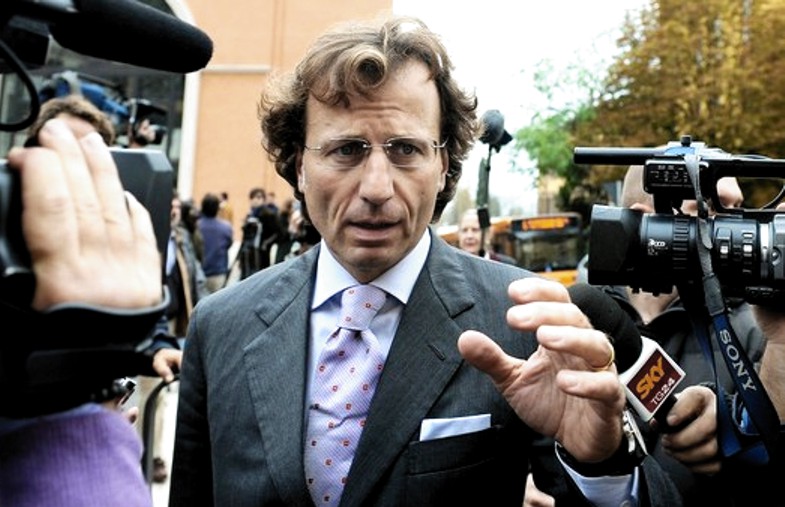
This excellent interview of Mr Maresca by Leonardo Molinelli just appeared in Canada Corriere.
The interview is similar to several others Mr Maresca has just given in Italy. Mr Maresca shows in all of them that he is very confident about the defense appeals not succeeding in any dramatic way.
Justice will be served in Kercher case
“The investigation was carried out very well”: lawyer
By Leonardo N. Molinelli
There’s less than a month to go to the start of the appeal process for the murder of 20-year-old American student Meredith Kercher. The next phase will begin on Nov. 24, which should establish the guilty parties in the death of Kercher, who was killed in Perugia, Italy between Nov. 1 and 2 of 2007.
Charged with first-degree murder, sexual assault, and theft is 26-year-old Amanda Knox and 23-year-old Raffaele Sollecito with whom Knox was having a relationship.
The other person facing charges ““ Rudy Guede from the Ivory Coast ““ will not be part of the process since he has already been condemned to 30 years [reduced to 16 at first appeal] at a summary procedure. He will face the Court of Cassation (appeals) for final sentencing [in December].
All three of the accused have always declared their innocence and the upcoming process promises to be controversial and sensational. The defence for Sollecito and Knox, in fact, has requested access to all forensic investigation from the Court of Cassation.
They’re requesting the analyses of all the principal exhibits, maintaining that the two were not present at the murder scene and thereby placing the blame squarely on Guede.
“The Kercher family has taught the world the dignity of silence.”
With these words, the family’s lawyer Francesco Paolo Maresca outlines the trial that went beyond the usual standards in legal battles in Italy, moving from the courtrooms to TV and newspapers.
Corriere Canadese/Tandem recently spoke to Francesco Paolo Maresca about the trial.
Has there been any new developments since the preliminary sentencing and the appeal?
“No, let’s say that the defence requested the appeals court for a review of all forensic findings, following the defence line in the preliminary trial, in which they contested all the assessments.”
Accusations that were discredited with the preliminary sentencing.
“Yes, so much so that the preliminary sentence is based on all these laboratory results accepted as fully reliable in the presence of the parties, and no one ever contested anything on that basis.”
So what is the defence’s objective in this case?
“They’re requesting, in substance, the detailed analyses of all the main exhibits, therefore the bra hook containing Sollecito’s DNA and the bathroom rug with Sollecito’s footprint.”
Do they intend to demonstrate the non-involvement of the two youths in the murder?
“They’re aiming to demonstrate the total non-involvement, unloading everything onto Rudy Guede.”
So Guede would have killed Meredith by himself while Amanda and Raffaele were in the wrong place at the wrong time?
“Actually, they say they were at Sollecito’s house after having smoked hash, made love, and woken up early the next morning.”
So they would have been connected to the crime scene as part of a conspiracy?
“They got there by coincidence based on test results. They say that the DNA on the bra isn’t Sollecito’s and if it were, it would have been found in other parts of the house, that the footprint on the rug isn’t Sollecito’s), that the DNA on the knife isn’t Knox’s, and so on.”
Instead, what are the facts as pieced together by the preliminary sentence?
“The facts pieced together would be a sexual attempt gone wrong, with a series of progressive and worsening knife wounds, with intimidation and threats and with three very serious wounds to the neck, of which one was fatal. We ““ and the sentencing acknowledges this ““ maintain that the facts cannot be viewed as a premeditated theft but as a crime of violence.
They probably attempted some sort of sexual game, Kercher refused, they threatened her, wounded her, blood spilled, and they panicked. Knox knew everyone so if they had called an ambulance or the police, they would have had to justify their presence, which is why they finished her off.”
So it wasn’t premeditated?
“There’s no premeditation. There is no premeditation. The event needs to be examined using the approach of a contingent situation, of the fear of being discovered, of the fear of making noise. Kercher screamed horribly from the pain, the simulation of a theft was to throw the research on the wrong track.”
America insists there were leaks in the Italian justice system, a conspiracy against Amanda, and so on. What impression did you get during this trial? Are there any deficiencies in this trial?
“The investigation was carried out very well, and forensic science and the police did a good job. There was just the one deficiency ““ and un-influential ““ of this blessed (bra) hook that was left behind and discovered 40 days later, but it was proven that it could not have been contaminated, using a series of technical valuations.
One must consider that 368 exhibits were gathered if I’m not mistaken, and above all we made an enormous commitment of deliberating for about a year (Editor’s note: January to December, 2009), which was very quick for Italian trials. Rudy Guede was examined with a summary procedure within a year of the act, and the other two to three years from the act, but with a deliberation that involved 170 witnesses and technical consultants.”
An exemplary trial considering that Italian justice system is often blamed for being slow.
“It gets blamed because they have completely different parameters and have juries and courts that dedicate themselves to a single trial ““ they begin and end that trial over three-to-four consecutive months, doing nothing else. In our system, the criminal court does this while the judges concurrently do another 20, 30 or 40.”
A difference in systems that could be the reason for these accusations.
“They were astounded because we didn’t have daily hearings. We pointed out that having weekly hearings on Friday, Saturday, and Monday ““ that is three days out of six ““ is a very unheard of commitment. We all risked our families because we couldn’t see them anymore”¦”
The defence for this case is reminiscent of the one used for the Cogne case, with the victim who disappears from the media, and the likely murderer who becomes a celebrity of sorts.
“From a theoretic interpretation, I’d say that’s justice, and I must say that Meredith Kercher’s family taught the elegance of silence to the entire world. Because as the families of Knox and Sollecito organized foundations, associations, sought funds, gave interviews, requested political help, Meredith Kercher’s family remained under the radar screen notwithstanding the offers, including financial (ones).”
Monday, August 09, 2010
The Judges’ Sentencing Report For The Guilty Verdicts In The Case Of Meredith Kercher
Posted by Our Main Posters
This is the report of Judge Massei and his colleagues, now translated into English.
This was a joint effort of PMF and TJMK and all who worked so hard on the report are active on Perugia Murder File and are or will be posters here on True Justice For Meredith Kercher.
The five months of work by all of us, on three continents, was done in memory of Meredith Susanna Cara Kercher, who was known to her friends as Mez.
Rest peacefully, Mez. We’d have been so honored to have been your friends.
Tuesday, June 22, 2010
The Aviello Story Seems To Show The RS & AK Defenses All But Concede Guilt Of All 3
Posted by Peter Quennell
Defenses Grasping At Straws?
The Sollecito defense latched with alacrity onto baby-killer and jailhouse-snitch Mario Alessi three months ago.
This seemed to have been widely taken in Italy as a sign of the Sollecito defense’s desperate weakness, rather than as a get-out-of-jail-free trump-card for RS.
Several weeks ago, the Amanda Knox defense latched onto Camorra clan-member and jailhouse snitch Luciano Aviello.
With a lot less alacrity though - his various stories have been around for a long time. This seemed to have been widely taken in Italy as a sign of the Knox defense’s desperate weakness,
Luciano Aviello, who is now in prison, and his brother Antonio, now on the run, are or were connected to the Camorra (NBC Dateline report above) which is Naples’s equivalent of the Cosa Nostra in Sicily and the NDrangheta in Calabria. The Camorra was in some ways the older, larger and badder of the several mafia arms.
Luciano Aviello and Antonio Aviello were living in Perugia at the time the crime against Meredith took place. Over a year ago, our poster Catnip posted this translation of a report from Italy on the Perugia Murder File board.
Saturday 09 May 2009
Prisoner writes: ‘I know real murderer’s name’
“I know the real name of Meredith’s killer, a fellow-brother Albanian friend of mine told me, and it’s not Raffaele Sollecito.” Luciano Aviello is Raffaele Sollecito’s ex-cellmate and, now, maybe encumbering his admirer, is writing another letter to Court of Assize president Giancarlo Massei.
A few weeks ago he had sent a letter in which he claims to have asked two of his friends to break into the murder house to prove that anybody could have done so. Yesterday, the page count of his letter jumped to five, and the tone was angrier.
He’s had it with journalists, because they’ve referred to his less than clear past, and because they wrote about his previous never-proven-true “revelations” on various important and dramatic criminal cases (like the disappearance of little Angela Celentano).
He’s had it with the police too, in whom he confided his secret about Raffaele’s innocence and who didn’t even give him the time of day.
He maintains that, actually, he has a letter written by an Albanian friend, which contains the real name of the murderer, and he wants to speak only to the court president, Giancarlo Massei, to reveal it to him.
Even the lawyer on the civil side of the case, Francesco Maresca, acting for the Kerchers, remains skeptical: “That letter ought to be re-read carefully: it’s not flour from his grainsack*”.
*****************
* This is a proverbial phrase (non è farina del suo sacco = “it’s not grist from his own mill”) meaning it wasn’t written off his own bat, and that other hands contributed to it.
And there is a video of a Sky News Italy report in Italian dated 21 April 2009 which in effect says “this isn’t any big deal’.
Judge Massei showed no interest in him. So Aviello and his kaleidoscopic claims thereupon went onto the back burner.
Fast-forward to several weeks ago, when the Knox defense engages in a high-profile, noisy flurry of activity to get a deposition from Luciano Aviello.
This time, Luciano recalls, it was actually his own missing brother who did it, and he himself buried some clothing, a knife, and some keys.
Casting total doubt on everything Luciano Aviello ever says, his hometown newspaper Il Mattino in Naples comes out with this report. It is our translation.
The Meredith Case - A Mariano Clan Supergrass Pops Up
“Amanda Is Innocent”
By Gigi di Fiore
In the newsroom of the Mattino he seemed at ease. Luciano Aviello was [20 years ago] just over twenty years old, and had asked to recount his experience as a “streetwise youth in the Mariano Camorra clan”.
In an earlier time, a war was in full swing in the Spanish Quarter [of Naples] between the Mariano clan, the “picuozzo” [another name for this clan after the “picuozzo” or cord around a monk’s habit] and the Di Biase family, also known as the “faiano”.
The DDA (Direzione Distrettuale Antimafia or Distict Anti-Mafia Directorate) did not yet exist, but Federico Cafiero de Raho was already employed as prosecutor in the investigations into organized crime.
It was he who dealt with that bloody war. Twenty years later, Aviello had become a news-magazine character. Now in his own words, he claims to have a rolet in the Perugia trial for the Meredith Kercher case as a “decisive” witness.
On 19 April of last year, he addressed two little hand-written pages to the President of the Court of Assizes of Perugia, Giancarlo Massei. He declared himself ready to tell the truth, and revealed that he had twice given some friends of his the task of breaking the seals on the house where the crime took place.
On 31 March of this year, Amanda Knox’s defense team video-recorded the declarations made by Aviello, who is now 41 years old. As the weekly news-magazine “Oggi” writes, he said: “It was my brother who murdered Amanda [sic]. I can recover for you the knife used in the crime and the keys of that house”.
This fellow arrived on the third floor of via Chiatamone [Editor’s office of the Mattino] wearing casual clothes with a pretence of elegance: he never retracts anything, always seeking to find suitable words to best describe his “revelations”.
Contact lenses, slim, a cousin killed because he was affiliated to the Mariano clan, Aviello spoke, revealing an outline personality, in a shadow world of braggadoccio, always on the sidelines of the dealings and violent acts of those in power among the clans of the Quarter at that time.
He ended up in jail, having confessed to a murder. It wasn’t true, but they had promised him 5 million lira, a lawyer and an annuity.
The clan didn’t respect the pact, and so he began to talk freely. Enticed by the good life, he began to act as a gofer/go-between selling “black lottery” tickets. He felt important. He earned 500 thousand lira per week.
It wasn’t bad. Then he did “embassies” [message-running], little services, but never great criminal leaps. The clans considered him “not very trustworthy”.
He was implicated in the investigation into the Spanish Quarter Camorra, and convicted.
Today, Federico Cafiero, now deputy prosecutor and DDA Coordinator for the investigations into the Caserta province clans, says of him: “He was altogether untrustworthy, although every so often he would invent a new one [new story]. A revelation, as he would call it, which would subsequently reveal itself to be out and out nonsense”.
Such as when he said that he knew where Angela Calentano was to be found, or that he knew the hideouts of the main fugitives of the D’Alessandro di Castellammare clan.
For his “revelations” against Tiziana Maiolo, ex president of the Justice Commission of the Chamber, he was hit with a trial, in 1997, for calumny.
Two years ago, he fired off his biggest tale yet: he accused a public prosecutor from Potenza in the famous trial on “dirty robes” between Catanzaro and Salerno. He was given an audience by the prosecutor Rosa Volpe in Salerno.
He had announced revelations. His contradictions were immediately exposed.
On those occasions also, the sources of his stories were newspaper articles or gossip with his cell-mates. Such as Raffaele Sollecito, or Gennaro Cappiello for the “dirty robes” investigation.
A compulsive liar, a seeker of publicity?
Twenty years ago, Aviello seemed to be a self-centred person, proud to present himself as a witness to “important facts”. But he never managed to arrive at a scheme of constant collaboration.
For various crimes, he has so far served 17 years in jail. Now the Perugia case appears. Who knows?
Our poster SomeAlibi seems to have had the last meaningful word on the absurdity of this tale. SomeAlibi posted this rather devastating satire on the PMF forum.
I can see it now..
Ghirga: “Well thank you Mr Luciano Aviello, that testimony I think the court will find extremely interesting concerning why Amanda Knox couldn’t have done the murder because it was your brother who was responsible. Despite the fact he’s missing. But thank you and I believe we’re finished.”
Luciano Aviello (quietly): “We ain’t finished”
G: “Uh?”
LA: “So, about this de-fa-may-shun thing.”
G: “Uh?”
LA: “She didn’t do it.”
G: “Sorry?”
LA: “She didn’t dooo it.”
G: “But Mr Aviello we brought you here to talk about the murder not the—”
LA: ”—see it sounds like you ain’t hearing me too good. Perhaps you need a little airation of your ears to help you with that. How would a 22 millimetre hole strike ya? She didn’t say nothing. She didn’t doooo it, capice?”
G: “But, she said it in interview. And in court. I mean, we were all there”
LA (putting tooth-pick on witness stand) “See, now you are making me repeat myself and I don’t like that at all, no I don’t. But I am a tolerant man, so maybe once more for luck ok? She didn’t dooooooooo it.”
G: “All of us were there!... She doesn’t actually disagree she said it…. hello… Mr Aviello… hello… what are you…. what are you doing… why are you counting?”
LA: “Now requiring this many pine boxes ain’t going to be ecologically acceptable my friend, so I suggest EVERYONE here learns to listen up real good ok?”
Court (all): “Huh?”
LA: “Repeat after me. She didn’t dooooooooooooooooo iiiit”
Court (all): “Like hell she didn’t”
LA: “Wise guys, huh?”
Well… that certainly went very well! This all reads like an Italian movie called in English Johnny Stecchino by Italy’s favorite funny actor Robertio Benignii
He accidentally finds himself confused with a mafiosos in Sicily, sees his days are very numbered, and starts talking fast. Very fast… He gets out of it, somehow, but the real mafioso still takes the hit.
Nice knowing you, Luciano…
Tuesday, May 25, 2010
The Chilling Killing Propensities Of Sollecito’s Various Knives
Posted by SomeAlibi
The few rather puerile websites trying to make the case that Knox and Sollecito were framed all have this one thing in common.
They are all of them a mile or more wide on the facts of the evidence - but only a millimeter or so deep.
Time and again on some point of evidence TJMK and PMF have gone far, far deeper than they have - and from then on, on that particular point, deafening silence is quite usual. Here is one very good example, on TJMK, highly incriminating in itself, and highly suggestive of when and how Edda Mellas first realised her daughter was guilty.
On that point of hard evidence, almost enough to incriminate Amanda all by itself, there has never been any real comeback. The PR campaign’s Wizard of Oz moves on.
Now we advance another in-depth analysis. This time it focuses on the really deadly nature of Sollecito’s various knives, and we’ll await the comeback if any with interest.
In effect, the deniers’ argument made is that Sollecito is not a collector or an aficionado, just a young man who might need to cut an apple with a pocket-knife. And he’s certainly not a hardcore knife collector, collecting fantasy-wish-list knives.
Carrying a pocket-knife above a certain size in public is illegal in Italy. But ignoring that technicality for a minute, let’s examine the knives of Raffaele Sollecito which were impounded during his arrest. Three knives, moving up in degrees of interest, not counting the very large knife prosecution witnesses identified as the murder weapon.
Knife Three
Take a look at the image up the top here. This knife actually hung above Sollecito’s bed.
It is a replica combat knife. The heavy t-bar protection is designed to protect the hand of the knife-user from slipping onto the blade when being used to stab another person, as well as to protect the user against another blade.
Blood grooves exist for only one purpose - as they imply, they are there for when one stabs someone deeply with the knife: they allow the blood to run out down the grooves. This breaks the seal and suction of the enclosing wound around the blade which makes the knife far easier to withdraw
That knife is specifically designed for stabbing people as well as cutting sentries’ throats etc. The female arm in the picture is Amanda’s by the way (you can find the zoomed-out version showing all of Amanda in the PMF gallery), as it was taken when she was being shown the knife in court.
She must have recognized it, of course, since it was from Raffaele’s bedroom, and would have been a rather noticeable discussion piece within view whenever Knox was in the room or laying on the bed.
Many teenagers and young adults put the objects of their highest interest and infatuation, from bands to film-stars, on their walls. Raffaele chose to put a knife designed for killing people on his wall.
It would be a lurking and incongruous presence on a small student-sized bedroom wall in the minds of the vast majority of people. The question of Raffaele’s degree of attraction to knives such that he actively chose to mount a replica combat knife on his bedroom wall doesn’t appear to need much further discussion.
And yet, it’s actually only less than a third of the equation as it was only a replica. Now let’s turn to two real knives - his so-proclaimed pocket knives - which Raffaele confirmed in his own words that he carried on him every day for years, and which tell a more subtle and deeper story.
First, consider what is the meaning of a pocket knife to you.
The phrase “˜pocket knife’ has been translated from the Italian from the transcripts / press coverage. For many, including myself, this will have conjured a mental image of a Swiss Army type knife or a simple blade and indeed this is the prevalent definition of a conventional pocket knife.
Let’s actually have a look at Raffaele’s “pocket knives” courtesy of pictures posted by poster Jools on PMF. These knives were impounded, one from the apartment and one, unbelievably, from Raffaele’s person at the Questura.
In the case of the latter, even Raffaele saw this as a devastating “own-goal” as we can read from his diary entry of 7 November 2007; “I’m not even able to offer guilt, given my deep fu**ing stupidity for the fact that I smoke cannabis I even forget what I have eaten and also for that I carry behind a knife to nock the tables and the trees and I carry it so often that I brought it also to the police headquarters.”
Knife Two
This is a 2.9 inch blade drop point, near spear point knife. At first glance (apart from the mark on the clip which should be ignored and was benign), the deniers camp might say “Well, look at it - it’s just a pocket knife even if it looks a bit sharp and so on ““ look, it’s even got a cute clip for the pocket, like on a pen.”
Let’s start there. The clip is actually a reversible one ““ it can be taken off and re-screwed to the knife to the user’s side / orientation of preference. This is already a proper knife rather than a cheap shop pick-up.
More obviously, the half-serrated edge to the blade for cutting is an active design (and purchase) feature.
Third, the “˜grind’ on the top the blade shows an aesthetic sensibility to the design but also serves a functional purpose for a cutting or stabbing use in terms of reducing friction.
Fourth, the serrations or (quite aggressive) “˜jimping’ on the top of the handle, just behind the blade are there to provide thumb grip.
Quite a lot of design features on this knife for a casual “pocket knife” one might think.
Which leaves us with the odd bar code thing at the top edge of the blade and the indistinct logo on the blade. Let’s see what that logo is with a little enhancing;
“˜Brian Tighe Design’. Brian Tighe?? Google sets us straight on who he is.
“You’d need a calculator to count the number of custom knife-makers who have jumped into the tactical fray over the past five years. You can tally the cream of the crop on two hands, being sure to earmark one of those digits for knifemaker Brian Tighe. In a matter of just a couple of years Tighe (pronounced “Tie”) has risen from the rank and file of edged weapons artisans to the rarefied air of the top 10 elite.”
A look at Tighe’s site shows that his own company’s knives sell for 500 dollars and up. He is a globally feted knife designer whose wait list for his knives was as high as seven years at one point.
So the design of the knife here is actually that of a noted master knife maker. Almost something one might collect, one might say. As loaded as Papa Doc Sollecito is, did Raffaele really spend over 500 dollars on such a knife?
Well no, actually, he didnt need to. This is a Columbia River Knife & Tool produced 811x series knife bearing Brian Tighe’s name. CRKT are a dedicated knife company who specialise in working with the world’s leading knife designers and producing the knives for a bigger market but still as proper aficionado pieces.
At this level of knife, there are extensive magazine, web and “˜user’ reviews. Knives like this are tested for resilience and sharpness including things like edge-on paper-cut tests where paper is cut through just like a razor from the side of a piece of paper held by one hand.
Such a knife is able to catch the edge of the paper and then slice straight through the width of the paper side-on without any tension in the paper. That’s what a knife like this is capable of. A “pocket knife” to me sounds like something picked up for 10 or 20 euro. The current model that replaced Raffaele’s now out-of-series model sells for about $80 at retail. Here’s the actual 2004 model that Raffaele had i.e. the same as the one above;
Worth looking at that for a second or two… Oh the bar code? It’s not a bar code, it a rectangular thumb stud you flick the knife open with. When you do, the knife goes to a locked position unlike many “pocket-knives”. In English speaking knife circles, these knives are not generally referred to as pocket-knives but are called “Tactical Knives” which are a cross-over of usage knives for outdoors / cutting etc but also for personal “protection”.
So, in addition to the wall-mounted replica combat knife, one of Raffaele’s daily carries (see diary / testimony) was a designer thumb-flicked locking tactical knife with jimping, top blade grind, switchable clip and a razor sharp edge costing about 80 bucks. That you can only carry in your pocket. Illegally. Some apple-cutter.
Let’s take a look now at the most worrying knife of all…
Knife One
At first glimpse, this “pocket knife” looks quite martial arts like, given the hole and the weird top edge of the blade and the spider logo.
The logo marks this as a Spyderco knife ““ a large premium knife manufacturer of tactical and many other types of knives. This particular model is a Delica4 Emerson Opener retailing for about $109.95rrp. Of particular note about this knife is the hole and the top edge. The hole, a Spyderco feature, allows a thumb to flick the blade open very quickly. This knife is about speed.
But actually the thumb hole is not the real speed feature ““ that is reserved for the top edge curl.
This is a truly specialist feature known as an Emerson Opener or “wave”. The idea is that the curl in metal catches on the edge of a pocket edge on drawing the knife and opens it immediately (see videos below).
This is a speciality feature licensed from Emerson knives ““ Emerson being another feted “˜name’ knife designer. The wave is only present on two of Spyderco’s 330 knives listed on their website ““ the Delica and the ¾ inch larger sister knife the Endura (“the best self defence knife in the world” according to one enthusiastic teenager on youtube). That’s how specialist it is.
The job of the wave feature is to provide the fastest opening knife in the world bar none ““ faster than a flick or spring knife in fact. This video (many similar to be found) gives a rather disturbing insight into what the real attraction of owning this knife is to a hardcore knife knut like Raffaele; (remember when you watch this for the first time that the knife is closed inside that pocket and also enable the sound on the embedded player below by clicking off the mute)
If I thought my son had a penknife, but then actually saw him with this, we would be having a very long chat..
“Enough!” the deniers say?! “You’ve still got it in for Raffaele haven’t you?” they say?! Despite the replica combat knife on the bedroom wall, the designer Brian Tighe Design CRKT drop-point and the Spyderco Delica4 with wave design)? “You’ve used prejudicial phrases like “hardcore knife knut” haven’t you?” they say?!
Sorry, but don’t look at me. They’re not my words.
They’re the words of Spyderco itself on its own webpage. See here and below.
Raffaele was out to impress Amanda and by his own admission both obsessive about her and a hardcore stoner. He also thought knives - proper knives with exclusive features by name knife designers not pocket knives were fascinating.
As with all of this case and any case, you REALLY need to look at the detailed evidence.
The overwhelming prevalence of skin-deep level of analysis / downplaying of this case by much of the deniers camp will lend and always has lent itself to people dismissing serious evidence as inconsequential based on their lack of understanding of what actually is in question.
The “mere pocket-knife” impression of Raffaele’s interest in knives is a clear case in hand. Raffaele’s father testified in court that his son carried a pen-knife. Some pen-knives or pocket-knives these really were…
As always with this case, when you take the time to look at the real detail, the reality you find is something far more disturbing…..
Monday, May 03, 2010
From The Book Darkness Descending: The Insights On Knox And Sollecito
Posted by Peter Quennell
This is Hamburg above. And that is Berlin and its parliament (the Bundestag) below.
Amanda Knox speaks German and she spent several months in these two cities, staying for some weeks in in Hamburg with her relatives, and several days in Berlin, before moving to Perugia to start her study period there.
Darkness Descending is the book on Meredith’s case by two British writers from which we excerpted on Meredith a few days ago.
As far as we know the writers did not visit Seattle, and their focus is more generally on Italy and to some extent the UK. But they did offer this brief take on Amanda Knox, and also one on Raffaele Sollecito.
**********
From Darkness Descending by Paul Russell and Graham Johnson (Pocket Books) pages 291 and 292
Meredith had enjoyed making the pop video with her University of Leeds friends, but Amanda’s summer job, before travelling around Europe and going to Perugia, had not been so successful.
A politically well-connected uncle in Hamburg had got her an internship to die for - a job working for a German MP at the Bundestag. Kindly Uncle Uwe also set Amanda up with a flat on the .outskirts of Berlin.
Astonishingly, two days later, his seemingly ungrateful niece walked out on the job without telling anyone, moaning that she had nothing to do and she wasn’t sure if she was getting paid. Again, money was a big feature in her thoughts.
She’d spent most of the time reading Harry Potter and showed no curiosity about how the parliament or the high-powered people in there worked. She ignored conversations about its history and architecture.
After walking out, she spent her time drinking wine in the local bars and reading more Harry Potter.
Two days later she left Berlin for Hamburg, where her uncle was waiting for her. He was furious - she had let him down.
It seems Amanda craved excitement on her terms, usually based on getting drunk and goofing around.
Her friends said she simply feared boredom like any young girl. She showed a healthy streak of youthful carelessness, they said, no worse or better than anyone else. A video posted on YouTube showed her drunkenly giggling in a friend’s kitchen after downing shots.
On campus, back in the US, Amanda had been fined for being drunk and disorderly at a party held in a fellow student’s house. During the incident she had also insulted the police.
However, her defenders gave another version, portraying a magnanimous Amanda. They said that in fact she was courageously fronting up for her underage friends, who were in no state to talk to the police; she was the only one sober enough to handle the situation.
A big plus in her character assessment, they said, possibly displaying a sense of chivalry that would later get her into deeper trouble in Perugia.
Despite her college party lifestyle, there was no denying that Amanda was clever and that she could compartmentalize her life.
She made the Dean’s List, an elite commendation of the University of Washington reserved for the institution’s brightest students, and an honour that would ultimately qualify her for a prestigious and sought-after place on the study-abroad exchange programme.
If Amanda wanted something, she would go all out to get it, no messing around.
Raffaele Sollecito’s later years were quite different: he seemed to laze around and evade responsibility.
He posted pictures of himself on the internet wrapped in blood-covered bandages, brandishing a meat cleaver, and wrote a weird story to go with the images. In a blog he expressed satisfaction at once being lodged in the same hostel as the infamous ‘Monster of Foligno’, a murderer who slaughtered two youths in the 1990s.
And yet his new-found fascination with gory horror and violent comics would have surprised the friends he left behind at Licea Scientifico Einstein secondary school at Molfetta.
They said Raffaele suffered from excessive softness - his kickboxing instructor recalled that he even hesitated when kicking out, for fear of hurting the hardened expert.
***********
A few interesting insights there, though we could use more on Sollecito. For most of it, this is a pretty good book, the weak part being the closing analysis of the evidence. Two small corrections.
- The house where the notorious rock-throwing party took place was where Knox herself was living at the time. See here.
- Knox was not on an official University of Washington study-abroad program, as the university has rather anxiously tried to make plain. See here.
If Knox had indeed been on a proper study-abroad program - something many caring parents actually insist upon - her behavior might have been more restrained. She may not have moved in with Sollecito for one thing.
She may not have hit the drugs so hard. And she would not have run so desperately short of money, just when Patrick was apparently about to hire Meredith to replace her. No monthly checks were arriving from Seattle.
Maybe the second correction is not such a small one.
In fact, it is a pity that no writers have really explored all of this - there is, if anything, a surfeit of motives in this case, and the writers might be able to narrow them down.
Although he went to highschool in Molfetta (bottom shot here) and the book is correct on that, Raffaele Sollecito actually comes from Giovinazzo which is ten minutes drive south along the coast.
Both are north of Bari, where his father practices medicine.
Tuesday, April 20, 2010
Knox Appeal Points Seem Essentially Points That Gained Limited Traction In The Trial
Posted by Peter Quennell
And the fact that the prosecution will get a shot at firming up their case does seem to have caught the defenses off-balance.
US-based Knox family legal advisor Ted Simon has appeared several times on US networks in the last few days, seemingly clean out of new ideas for how to get Amanda Knox off.
No motive? Well, a motive does not have to be confirmed in Italy, but Micheli, Mignini and Massei all suggested credible motives, each involving an escalation of violence, and each probably involving drugs as one component - drugs like enhanced (skunk) cannabis, crystal meth, and cocaine increasingly seem to be triggering psychotic episodes that can lead to murder.
No DNA in the room? Well, most murders take place with no DNA left behind, and if Knox was the one simply holding the large knife and uttering threats, there is no reason why her DNA should have have deposited. Rudy Guede left only a few microscopic traces of DNA, but clearly he too was in the room. And there was plenty of forensic evidence implicating Knox right outside of Meredith’s door.
And as usual, Ted Simon skirts the very problematic rearrangement of the crime scene, and the testimony of various key witnesses, and the very incriminating pattern of phone calls, and the major discordance between all the alibis.
Pity that the US reporters never ever seem to press him on these things.
And in Perugia, it seems that Mr Ghirga and Mr Della Vedova are also only going through the motions - recycling just a few of their points that were already not too convincing at the trial. Andrea Vogt reported on the grounds for their appeal in the Seattle Post Intelligencer.
The 220-page document filed with the of Court of Appeals in Perugia on Saturday morning is a total appeal of all the points of the sentence, said Knox’s lawyer, Luciano Ghirga from Perugia in an interview with the Seattlepi.com.
“It includes the first days of the interrogation, the DNA and the traces detected with luminol. We re-iterate the innocence of Amanda and remain convinced there is not proof of her presence at the scene of the crime,” Ghirga said….
The hotly contested forensic evidence presented in the trial played an important role in the jury’s reasoning but was not the only element that led them to convict. Inconsistent statements, witness testimony, Knox’s placing the blame on an innocent man, which she maintains she did under police pressure, and the staging of the crime scene were also cited as key factors by the jury.
Knox’s legal teams are expected to contest all points, but are also asking for a third-party review of the forensic evidence. Such a request was rejected once already during the 9-month trial, but a different appeals court judge could decide to grant such an independent review. In Knox’s case, lawyers are contesting the kitchen knife that prosecutors said was the murder weapon that had Knox’s DNA on the handle and a trace amount of Kercher’s on the blade.
Knox’s lawyers also contest the luminol-positive traces discovered in the corridor (footprints) and the spot in the roommates room where prosecutors say Knox and her boyfriend, Raffaele Sollecito, later staged a break-in to make the scene look like a rape-robbery to throw off investigators. Police biologist Patrizia Stefanoni testified during the trial that these luminol-positive traces had mixed genetic material of Knox and Kercher.
Friday, March 12, 2010
Rudy Guede Now Counter-Claims From Prison That Knox And Sollecito Were Real Instigators
Posted by Tiziano
Please click here to read Rudy Guede’s hand-written letter from Viterbo Prison (above) in Italian.
Below is our translation of the letter as posted by TGCom.
Rudy Guede was obviously provoked into putting his version of events out by the claim of Alessi (see video at bottom of this post) that he had a colleague with him on the night, and also by the finding of the judges in the Dispositivo that he was the prime instigator.
The complete text of the letter written by the Ivory Coast man.
Guede’s letter to News Mediaset.
Viterbo 07/03/2010
As usual in this beloved beautiful country of ours, there are many dishonest people given over to lying. And there are likewise those who give these people a voice without the slightest questioning of their consciences, whether it’s worth the trouble of giving space to certain conjectures.
In recent days the only things I have heard have been blasphemous insinuations about me; baseless gossip which has done nothing other than harrying, hither and thither, TV news channels, even though for reasonable people it is the pure invention of a wicked mind.
It must be said that all I have heard in recent days in the media, about what has been falsely stated by this foul being by the name of Mario Alessi, whose conscience is nothing but stinking garbage, are purely and simply the ravings of a sick and twisted mind, his ravings are the dreamed-up, untrue declarations of a monster who sullied himself with a frightful murder in which he took the life of an angelic little human being, as is known throughout Italy. This fellow, now, is telling lies about things that I never said to him and (other things) that I never said, things that don’t exist either in this world or the next.
To his ““ or rather their- rotten declarations, it’s my intention to put in black and white that I never confided in this disgusting creature, since moreover that I’ve got nothing to confess or anything else (to say), and everything that I had to say I have already said to the judges and I will go on shouting and fighting while I am still alive, until the truth itself and justice itself prevail over such lies, and even less did I speak one to one or together with other people or with other inmates about my trial affairs, and if I had ever had something to say, don’t you believe that I would have talked about it with my lawyers? Giving rise to and giving credit to what is a blasphemous statement made by a sick mind, to a monster who had no pity for a child.
With this latest scenario, which my lawyers, my family and I are now used to, from this latest person, the monster Alessi, I hope that Italians and the rest of the world realise that they are dealing with pigs, pigs which stink of the slime of falsehood, but which, not withstanding everything, go around showing their faces and suffocating people with their fetid lying.
Like their umpteenth scenario which does nothing more than give me the strength and the awareness to struggle more than ever, so that the truth that they want to hide is revealed for everyone to see.
As far as I’m concerned, (I have) the serenity and the calm of complete peace of mind, as a person who does not parade this unfair suffering, but who trusts in justice and in the good sense of Italians.
And finally I wish that sooner or later the judges will recognise my complete non-involvement in what was the horrible murder of the splendid, magnificent girl who was Meredith Kercher, by Raffaelle Sollecito and Amanda Knox.
Guede Rudy
Below: Alessi’s statement at Viterbo Prison to Raffaele Sollecito’s defense team. Warning: this very self-serving statement by Alessi is graphic and offensive, as well as, in our view, almost certainly untrue.
Rudy Guede will be interrogated on the claims in this statement today Friday by Mr Mignini and Ms Comodi at Viterbo Prison. There could be news coming out of this interrogation later today.
Thursday, March 04, 2010
Judges’ Sentencing Report Released In Perugia And It Is 427 Pages Long
Posted by Peter Quennell
Judge Massei is seen above on live TV from the court on the night he announced the verdict and sentence.
The sentencing report is four times the length of the Micheli report a year ago which itself was very detailed. It was made available to the media today on paper by the court in Perugia.
First take in the Italian media is by TGCom.
The judges of the Court of Assizes of Perugia lodged the grounds for the condemnation of Raffaele Sollecito and Amanda Knox for the murder of Meredith. All the issues raised in the process, it says, “demonstrate a comprehensive and unified whole, without gaps and inconsistencies”... The reasons for conviction of two defendants are contained in a voluminous file. It is 427 pages signed by the President of the Court Giancarlo Massei and assessor Beatrice Christians.
The motive is described in the report as essentially the thrill of the moment in helping Rudy with a sexual attack and while there was a predisposition there was no longer term intention.
Drugs are seen as having played a role.
Sollecito and Knox are apparently seen in the report as the knife wielders and one of them seems to have delivered the fatal blow.
We will be obtaining the report of course and arriving at our own English-language version in the next several weeks.
RIP poor Meredith. This has to be so tough on her family and her friends. We love this photo below. So trusting and so full of life.

